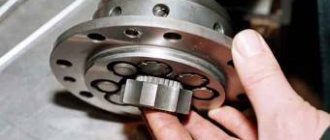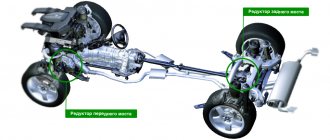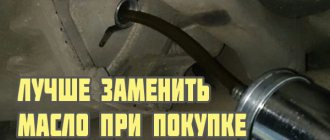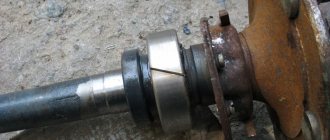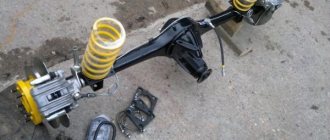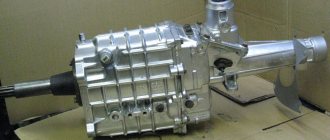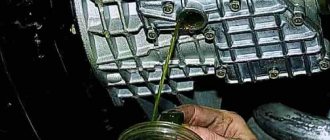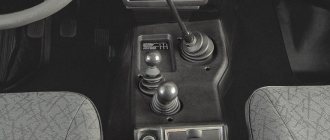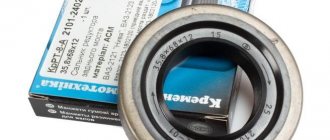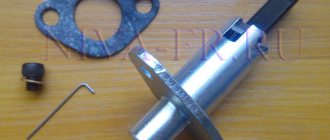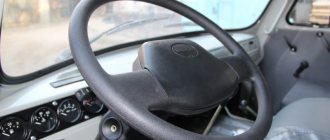All VAZ classic cars are rear-wheel drive, the vehicle moves using the rear axle, which is the drive axle. The VAZ rear axle gearbox is the most important part in the transmission; it is where the main gear is located.
- 1 Device
- 2 Differences in VAZ rear axle gearboxes
- 3 Gearboxes on machine 2107
- 4 Replacing the rear axle gearbox of VAZ 2106, 2107
- 5 Defects in the gearbox
- 6 Adjusting the VAZ rear axle gearbox
- 7 Repair or replacement, which is better
- 8 Locking the VAZ rear axle gearbox
A lot depends on the gearbox - if it is faulty and humming, the car can get stuck in the middle of the road at any moment and will have to be towed. The speed of the car depends on the gear ratio (TR) of the main pair in the rear axle gearbox (REA) - the lower it is, the faster the car will move. But too high a speed loads the engine and transmission, so when replacing REM, owners of VAZ 2101-07 vehicles must take into account the power and volume of the internal combustion engine (ICE), and install a gearbox that optimally matches the technical characteristics of the vehicle.
Device
In order for the car to move, it is necessary to transfer the rotation of the engine to the wheels. But the engine speed is too high, and in order to correctly distribute the torque, a mechanism is necessary that changes the gear ratio. Due to the gearbox and different engine speeds, the speed of movement changes, and the main pair of the rear axle takes over the rotation and transmits it to the wheels through gears.
The VAZ rear axle gearbox consists of the following parts:
- flange, it is fixed on the drive gear (shank) of the RZM, and is an intermediate link between the driveshaft and this gear;
- the shank of the main pair, at one end of which there are splines for pressing the flange, at the other end there is a bevel gear with a small number of teeth;
- driven gear (planet), it is in mesh with the drive gear, and it is with it that it forms the main gear;
- center differential, which allows the rear wheels to rotate at different angular speeds.
The differential design is very simple - the mechanism consists of two axle gears, two satellites and a satellite pin. From the gearbox, the movement is transmitted to the axle shafts, on which the wheels are mounted.
Design specifics of the rear axle gearbox
Wheels with meshing teeth that transmit torque to the driven shafts from the drive shaft are called gears. Due to the fact that the shafts are located at different angles, the teeth of the wheels are made of a special shape - this is the so-called. bevel gears.
Thanks for subscribing!
The cone shape, in addition to its main purpose of transmitting torque, also provides a low noise level, which is an advantage in terms of ease of operation of a passenger car.
The drive wheel must be of a different size than the driven ones - only in this case will a reduction in gear be ensured. If this requirement is met, several full rotations of the driven shaft will correspond to one full revolution of the driving shaft - in other words, there is a decrease (reduction) in the rotation speed. There are a number of vehicles (all-terrain vehicles, for example), where a serious reduction in rotation speed is applied in the gearbox - thus ensuring a very low pace of movement so as not to get bogged down.
Differences in VAZ rear axle gearboxes
RZMs differ in the gear ratio of the main pair; in total, there are four types of gearboxes for VAZ classics:
- 2101;
- 2102;
- 2103;
It is the RZM 2102 that is “quiet”, its drive gear has 9 teeth, and the driven gear has 40. To calculate the gear ratio, you need to divide the number of planetary gear teeth by the number of teeth on the drive shaft for the VAZ 2102 FC is equal to 4.44.
The “penny” gearbox (2101) accordingly has the number of teeth on the gears 10/43, so its IF is 4.3. The next, faster one is RZM 2103 - it has a ratio of 1041, which means the gear ratio is 4.1. And finally, the “fastest” will be the 2106 gearbox, with the number of teeth 11/43 and an inverter speed of 3.9, respectively.
A lot of VAZ 2101-07 owners strive to install the fastest gearbox, but this is not always necessary. If the car often carries cargo, that is, the car is a “workhorse”, high speed is of no use, but high-torque power will be very useful. It should be noted that RZM 2102 was not supplied as spare parts; it was installed only on station wagons.
Where are the gear ratios written?
Raise the rear wheel, put it in neutral, make 10 rotations of the wheel and count the revolutions of the cardan.
Cardan speed 19.5 20.5 21.5 22.5
Gear ratio 3.9 4.1 4.3 4.44
What does the gear ratio give? The higher it is, the lower the speed in all gears at the same speed. On standard sixes with a 1500 engine, a 2105 gearbox and a 4.1 axle are installed at the factory. If the engine is 1600, then the gearbox is original (2106), the axle is 3.9 or 4.1.
Let's assume that all cars have 175/65R13 tires.
Let's now look at the graph of the dependence of the car's speed on the engine speed (always on the graphs the standard 1500 with a 2105 gearbox and a 4.1 axle will be indicated in green. Why - because there are more of them than all the others).
With a 2106 gearbox and a standard 4.1 axle (raspberry) with a standard engine, we get a gain in dynamics only due to the long 1st gear, the 2.3 has become longer, which is not good (with a standard engine).
Here all the gears are longer (especially the first). For example, in our version in first gear the speed range of 3500-6500 is at a speed of 28-53 km/h, and in the standard it is at 25-45 km/h. Feel the difference! By the way, in this configuration, the first, second, third gears completely coincide with the 11th row on the chisels (with a 3.7 axle), the fourth is shorter, and if the fifth, then it is not much longer than the chisel fourth gear... truly, everything new is well forgotten old :).
Another thing is if we install a bridge of 4.44 (raspberry): Compare: 1 is longer, 2.3 is shorter, 4 is shorter!!
That is, from a traffic light in first gear, we rev up the engine when the “standard” is already shifting to 2, then second, third, fourth, and we go forward.
This option is optimal for a standard engine. However, there is a minus: in 4th gear, already at 140 km/h the revolutions will be 6000... here it is better to use standard 5th gear, which will create a complete picture. Here you have the highway, and the city - and the wolves are fed up and no one was hurt. And due to the fact that at maximum speed modes the revolutions will be close to maximum, the dynamics on the track will be amazing.
- Always correctly replace a faulty gearbox or its parts;
- understand how the car will behave when installing a gearbox with parameters different from the original factory ones.
The easiest way to find out the gear ratio of the rear axle of a car is to look in the documentation. For many foreign cars this number is encrypted in the Vin number. For domestic cars, there are standard gearboxes for certain models. At the same time, there are cars that can be equipped with a number of gearboxes with different gear ratios.
It is possible to find out information specifically and in detail. There is no need to remove the gearbox for this. If there is information, it is located in a place convenient for inspection.
What happens if the gearbox being replaced has different parameters from the installed ones? For example, consider the gear ratios of VAZ gearboxes. The line of units is represented by four gearboxes. Their numbers fall in the range from 3.9 to 4.44.
A gearbox with a number of 3.9 will be the fastest of the family, and a gearbox with a number of 4.44 will be the most high-torque. Because in the first case, the power transmitted by the input shaft decreases only 3.9 times versus 4.44. It turns out that if the gearbox transmits torque faster, the car becomes more “nimble”. If you replace the gearbox with a version with a lower gear ratio, the car accelerates more slowly, but becomes more passable and high-torque.
When installing a gearbox with a number different from the factory number, it is imperative to check the speedometer readings. Most often he starts to lie. The problem can be solved by adjustment, and sometimes you have to change the speedometer cable. The most difficult thing when replacing a gearbox is not the removal and installation, as it might seem initially, but the adjustment and configuration. Without proper adjustment, even a properly selected gearbox can become unusable after several thousand miles.
What gear ratio of the VAZ rear axle gearbox can be considered optimal? Each Zhiguli car owner will decide the answer to this simple question himself. To do this, it is enough to understand for what purposes the car will be used. If this is primarily a workhorse, the best option would be the most powerful gearbox with a 4.3 number.
A few words about the gear ratio of all-wheel drive VAZ-2121 gearboxes. Since there are two gearboxes on such cars, it is important that the number is the same and corresponds to the ratio 41: 10 = 4.1.
To complete the picture, let’s consider foreign versions of gearboxes and their numbers. A good option for comparison would be the rear-wheel drive models of the German auto giant BMW. BMW gear ratios range from 3.07 to 4.1. Moreover, the number of unit models exceeds ten. Just from this indicator you can understand how often foreign designers make changes to car components.
The most dynamic gearbox with a number of 3.07 is found in models of the E90, E91 and E92 series. If we look at powerful options, we can highlight the BMW X5 with a 3-liter engine, which has a rear gear ratio of 4.1.
Another thing - if we install a bridge of 4.44 (raspberry): Compare: 1 is longer? 2,3-shorter, 4-short!!
Replacing the rear axle gearbox of VAZ 2106, 2107
The main disease of REM is increased noise (humming), and the gearbox can hum for various reasons:
- there is insufficient oil in the bridge, or it is completely missing;
- the gap between the gears of the main pair is not adjusted;
- the gears are worn out, they have chips and other damage;
- the main pair has a manufacturing defect, the gears are not ground in from the factory;
- the shank nut has become unscrewed or loosened;
- bearings are worn out.
The main malfunction of the center differential is the wear of the gears of the axle shafts and satellites, when the surfaces of the parts are heavily worn, play forms between the differential gears, but the rear axle usually does not make noise due to wear of the differential gears.
ZM gearboxes on VAZ classics are subject to repair, but only if there is no wear on the gears. If the mechanism can no longer be repaired, it needs to be replaced. Replacing the rear axle gearbox of a VAZ 2106 on a “seven” is carried out as follows:
- we install the car on a pit or a car lift; changing the gearbox on the ground is extremely inconvenient;
- If the car is installed on a pit, both sides must be jacked up; in any case, the rear wheels must be removed. If the work is carried out on a lift, you should install stops under each side of the car (in the rear);
- unscrew the drain plug in the REM, drain the transmission oil, having previously prepared a container for it;
- remove the rear brake drums (two guide bolts on each side), after first removing the car from the handbrake. The drums can be difficult to remove; they are dismantled by tapping them from behind with a hammer through a wooden block. You cannot hit the drum with a metal hammer; the drum may break;
- remove the brake pads;
- unscrew the fastenings of the rear axle axle shafts on each side, each axle shaft is secured with four nuts;
- we press out the axle shafts, for this you will need a special puller, you can also make a homemade device;
- remove the driveshaft by unscrewing the four bolts and nuts. If the same REM is installed, the cardan with the shank must be marked; this is done in order to put the shaft back in the same position. If you install the cardan incorrectly according to the marks, the shaft may begin to vibrate;
- unscrew the eight bolts securing the rear gearbox (key 13), remove the assembly.
At this point, the removal of the gearbox can be considered complete; now all that remains is to either repair the mechanism or install a new one instead.
Functions and principle of operation
The rear axle reducer (RAG) is part of the vehicle transmission. This unit changes the direction and increases the value of torque, which is transmitted from the driveshaft to the axle shafts of the drive wheels . The engine rotates at high speed (from 500 to 5 thousand revolutions per minute), and the task of all transmission elements is to transform the direction and angular speed of the rotational movement of the motor and ensure the efficient operation of the drive wheels.
Technical characteristics of the gearbox
The VAZ 2103 gearbox is suitable for any “classic” VAZ model, but engine performance may change after installing a “non-original” gearbox. This is due to the design features of such a gearbox.
Gear ratio
Each type of REM installed on the VAZ 2101–2107 is characterized by its own gear ratio. The lower the value of this indicator, the more “speedy” the gearbox is. For example, the gear ratio of a “penny” RZM is 4.3; a gearbox with a gear ratio of 4.44 is installed on a “two”, i.e. the VAZ 2102 is a slower car compared to the VAZ 2101. The VAZ 2103 gearbox has a gear ratio of 4, 1, i.e. the speed indicators of this model are higher than those of the “kopek” and “two”. The fastest of the “classic” REMs is the unit for the VAZ 2106: its gear ratio is 3.9.
Video: a simple way to determine the gear ratio of any gearbox
Number of teeth
The gear ratio of the RZM is related to the number of teeth on the gears of the main pair. On a “three-piece” RZM, the drive shaft has 10 teeth, the driven one - 41. The gear ratio is calculated by dividing the second indicator by the first, i.e. 41/10 = 4.1.
The number of teeth can be determined by the gearbox markings. For example, in the inscription “VAZ 2103 1041 4537”:
- VAZ 2103 - gearbox type;
- 10 and 41 - the number of teeth of the drive and driven shafts, respectively;
- 4537 — number of the final drive gear set.
Consequences of installing a non-standard gearbox
You should know that installing a “faster” REM does not mean an automatic increase in vehicle speed. For example, if on a VAZ 2103, instead of the “native” gearbox with a gear ratio of 4.1, you use a VAZ 2106 unit with a gear ratio of 3.9, then the car will become 5% “faster” and the same 5% “weaker”. It means that:
- effective torque will decrease by 5%;
- to accelerate to a certain speed, fewer engine revolutions will be required, i.e., to accelerate, for example, to 120 km/h, 3900 rpm will be enough, instead of 4400. The problem is that now the engine may not have enough power to spin up to 3900 rpm.
Thus, if you installed a non-standard RZM with a different gear ratio on a VAZ 2103, then in order to maintain the dynamic performance of the car, a proportional change in engine power will be required.
Any gearbox can be installed: if it is normal, it will not hum with any gearbox. However, you need to take into account the gear ratio: if you set it with a lower number, the car will be faster, but it will go slower. And vice versa - if you set it with a larger number, it will take longer to accelerate, but go faster. The speedometer readings also change. Don’t forget about the traffic cops: it’s better to install the same one as it should be, and it’s better for the engine.
genchik64
https://vaz-2106.ru/forum/lofiversion/index.php/t5261–600.html
Defects in the gearbox
Increased play in the RZM can be formed due to wear of the differential pinion pin - if you grab the driveshaft and rotate it clockwise and counterclockwise, this play can be felt. Also, increased clearance may occur due to wear of the splines inside the differential housing.
If the gaps in the main pair of gearboxes are not adjusted, a characteristic noise occurs when the car moves:
- when the load increases (sharp acceleration), a characteristic howl is heard in the bridge;
- When I let off the gas the noise goes away.
The engine can hum in a different way, but the characteristic feature described above can most often be heard on VAZ classic cars. Worn teeth of the main pair are clearly visible on the planetary gear - they become rounded, and they often show traces of rust.
Adjusting the VAZ rear axle gearbox
If the main pair in the gearbox is worn out, it must be replaced. But you can’t just put the gears back in place; the gaps in them must be adjusted. In total, two types of basic adjustments are made:
- The thickness of the adjusting sleeve (washer) is selected for the shank (drive gear). The washer can have a thickness from 2.6 to 3.5 mm;
- The gap between the gears of the main pair is adjusted using two adjusting nuts of the differential housing.
The washer for the shank is selected in such a way that the shaft with the drive bevel gear rotates in the gearbox housing without backlash with a force by hand (0.3-0.4 kg). In this case, the shank nut must be tightened with a force of 12 to 26 kg, usually 18-19 kg are tightened.
After installing the shank, the differential housing with the planetary gear attached to it is put in place. The housing is secured with two covers (4 bolts, a knob with a 17mm head). The adjusting nuts are tightened on the sides of the bearings, the differential is installed so that there is play between the gears of the main pair, and the planetary gear should not be clamped. By moving the adjusting nuts to the right and left, the shank gear is brought to the planetary gear. By adjusting, you select the moment when the gap between the gears practically disappears.
The last stage is to adjust the preload of the differential bearings; the adjusting nuts are tightened on the sides. Such work must be carried out with an indicator, the device should show from 0.14 to 0.18 mm, the gap between the gears should be within 0.08-0.13 mm. After the operation, the adjusting nuts are fixed with plates so that they do not return.
It should be noted that adjusting the rear axle gearbox of a VAZ is a very difficult matter, and it is better to trust professionals.
Repair or replacement, which is better?
Car owners of VAZ classics often cannot decide what is best to do - buy a complete ready-made REM assembled or purchase individual parts and repair the gearbox. It’s really difficult to decide here - the price of a new gearbox, of course, is higher, but the owner of the car is freed from the headache of adjustment. The thing is that it’s not so easy to find a good master of VAZ gearboxes, and there is no guarantee that the new main pair will not hum.
If a car owner buys a new gearbox, but it hums, the part can be exchanged under warranty, but the car owner loses money on removing and installing the gearbox. If you purchase a defective main pair, the repair itself costs more - you will have to pay the technician for the secondary partition of the gearbox.
